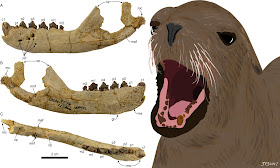holotipo de Olympicetus incluye una buena cantidad de dientes, los cuales demuestran que esta especie tenía dientes heterodontes, eso quiere decir que los dientes estaban diferenciados a lo largo de la dentadura. Esto es una característica heredada de otros cetáceos ancestrales, como contraste, la mayoría de odontocetos modernos tienen una dentadura homodonte, o sea, que todos los dientes son iguales y no puedes distinguir anteriores de posteriores. Desafortunadamente los dientes de Olympicetus se habían caído durante el proceso de fosilización, y la posición exacta de cada diente solo se pudo estimar comparando con otros odontocetos con dentaduras heterodonte, como por ejemplo Xenorophus sloani Kellogg, 1923, del Oligoceno temprano de Carolina del Sur.
ecolocalización (Churchill et al., 2016; Park et al., 2016). La presencia de odontocetos en depósitos del Oligoceno en la región del Noroeste del Pacífico es bien conocida entre los paleontólogos ya que ha sido mencionado en la literatura científica durante los últimos 40 años (e.g. Whitmore & Sanders, 1977; Barnes et al., 2001). Sin embargo, solo dos especies habían sido descritas previo a Olympicetus, ambas perteneciente a grupos distintos. De estos el más reciente que fue descrito es el allodelphinid Arktocara yakataga, Boersma & Pyenson, 2016, proveniente de depósitos del Oligoceno de Alaska. Los allodelphinids son un grupo de odontocetos de rostro alargado que incluye las especies: Allodelphis pratti, A. woodburnei, Goedertius oregonensis, Ninjadelphis ujiharai, Zarhinocetus donnamatsonae y Z. errabundus (Boersma & Pyenson, 2016; Kimura & Barnes, 2016). Este grupo en particular está actualmente extinto, pero están relacionados al Delfín del Ganges (Platanista gangetica) el cual es uno de los pocos delfines de río actuales y el último sobreviviente de un grupo que fue mucho más diverso en el pasado.
 |
| Vista dorsal de Goedertius oregonensis (LACM 123887) del Mioceno temprano de Oregon. Aquí podemos observar el rostro alargado que distingue a esta especie y otras relacionadas a la misma. |
 |
| Relación filogenética de Olympicetus con otros odontocetos (modificado de la Figura 9 de Velez-Juarbe, 2017). |
References
Barnes, L. G., J. L. Goedert, and H. Furusawa. 2001. The earliest known echolocating toothed whales (Mammalia; Odontoceti): preliminary observations of fossils from Washington State. Mesa Southwestern Museum Bulletin 8:92-100.
Boersma, A. T., and N. D. Pyenson. 2016. Arktocara yakataga, a new fossil odontocete (Mammalia, Cetacea) from the Oligocene of Alaska and the antiquity of Platanistoidea. PeerJ 4:e2321. doi: 10.7717/peerj.2321
Boessenecker, R. W., D. Fraser, M. Churchill, and J. H. Geisler. 2017. A toothless dwarf dolphin (Odontoceti: Xenorophidae) points to explosive feeding diversification of modern whales (Neoceti). Proceedings of the Royal Society B 284:20170531.
Churchill, M., M. Martinez-Caceres, C. de Muizon, J. Mneckowski, and J. H. Geisler. 2016. The origin of high-frequency hearing in whales. Current Biology 26:1-6.
Fordyce, R. E. 2002. Simocetus rayi (Odontoceti: Simocetidae, New Family): a bizarre new archaic Oligocene dolphin from the Eastern Pacific. Smithsonian Contributions to Paleobiology 93:185-222.
Geisler, J. H., M. W. Colbert, and J. L. Carew. 2014. A new fossil species supports an early origin for toothed whale echolocation. Nature 508:383-386.
Kellogg, R. 1923. Description of an apparently new toothed cetacean from South Carolina. Smithsonian Contributions to Knowledge 76(7):1-7.
Kimura, T., and L. G. Barnes. 2016. New Miocene fossil Allodelphinidae (Cetacea, Odontoceti, Platanistoidea) from the North Pacific Ocean. Bulletin of the Gunma Museum of Natural History 20:1-58.
Park, T., E. M. G. Fitzgerald, and A. R. Evans. 2016. Ultrasonic hearing and echolocation in the earliest toothed whales. Biology Letters 12:20160060.
Velez-Juarbe, J. 2017. A new stem odontocete from the late Oligocene Pysht Formation in Washington State, U.S.A. Journal of Vertebrate Paleontology, DOI:10.1080/02724634.2017.1366916
Whitmore, F. C., Jr., and A. E. Sanders. 1977. Review of the Oligocene Cetacea. Systematic Zoology 25:304-320.






